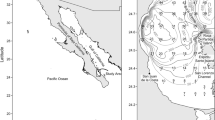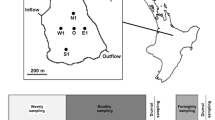Abstract
Physical, chemical and biological observations made in late July and August 1997 across the Azores Front (37° N, 32°W to 32° N, 29°W) are presented. The objectives of the study were: (1) to analyse horizontal and vertical profiles of temperature, salinity, density, nutrients and chlorophyll-a (Chl a) of the top 350 m; (2) to identify the main differences in the deep Chl a Maximum (DCM) and hydrographic structure between the water masses that pass north and south of the Azores Front; and (3) to estimate phytoplankton primary production in these water masses. Horizontal and vertical profiles of salinity, temperature, density, nutrients and phytoplankton pigments in the top 350 m were analysed. The Front separates two distinct water types: the 18 °C Mode Water (18 MW) of sub-tropical origin, and the 15 °C Mode Water (15 MW) of sub-polar origin. Differences in the DCM and hydrographic structure between 18 MW and 15 MW were observed in the contour plots of each section. The average Chl a concentration between 5 and 200 m depth decreased significantly from 15 MW to 18 MW. The same pattern was observed for the Chl a concentration at the DCM depth. A vertical one-dimensional model was used to estimate the phytoplankton primary production in the 15 MW and 18 MW and led to an estimated water column average gross primary productivity (GPP) between 1.08 and 2.71 mg C m−3 d−1 for the 15 MW and about half of these values for the 18 MW. These results indicate that the typical south–north positive slope on DCM depth parallels a latitudinal increase on GPP, suggesting that the location of the Azores Front may have a significant regional impact on GPP.
Similar content being viewed by others

References
Alves, M. A., A. Simõ es, A. C. De Verdiére & M. Juliano, 1994. Atlas Hydrologique Optimale pour l'Atlantique Nord-Est et Centrale Nord (0°-50°W, 20°-50°N). Université des Aç ores, 76 pp.
Alves, M., 1996. Dynamic instable d'un Jet Subtropical. Le cas du systéme Fron-Courant des Aç ores. PhD thesis at the “Université de Bretagne Occidentale-Laboratoire de Physique des Oceans”, Brest, France: 229 pp.
Aminot A. & M. Chaussepied, 1983. Manuel des analyses chimiques en milieu marin. Centre national pour l'exploration des océans (CNEXO). Brest, France: 395 pp.
Angel, M. V, 1989. Vertical profiles of pelagic communities in the vicinity of the Azores Front and their implications to deep ocean ecology. Prog. Oceanogr. 22: 1–46.
Bienfang, P. K., J. Syper & E. Laws, 1983. Sinking rate and pigments responses to light-limitation of marine diatom: implications to dynamics of chlorophyll maximum layers. Oceanol. Acta 6: 55–62.
Brock, T. D., 1981. Calculating solar radiation for ecological studies. Ecol. Model. 14: 1–19.
Cloern, J. E., C. Grenz & L. Videgar-Lucas, 1995. An empirical model of the phytoplankton chlorophyll:carbon ratio-the conversion factor between productivity and growth rate. Limnol. Oceanogr. 40: 1313–1321.
Cullen, J. J., 1982. The deep chlorophyll maximum: comparing vertical profiles of chlorophyll a. Can. J. Fish. aquat. Sci. 39: 791–803.
Dippner, J. W., 1993. A lagrangian model of phytoplankton growth dynamics for the Northern Adriatic Sea. Cont. Shelf Res. 13: 331–355.
Duarte, P. & J. G. Ferreira, 1997. Dynamic modelling of photosynthesis in marine and estuarine ecosystems. Env. Model. Assess. 2: 83–93.
Eberlein K. & G. Kattner, 1987. Automatic method for the determination of orthophosphate and total dissolved phosphorus in the marine environment. Fres. Z. Anal. Chem. 326: 354–357.
Eilers, P. H. C. & J. C. H. Peeters, 1988. A model for the relationship between light intensity and the rate of photosynthesis in phytoplankton. Ecol. Model. 42: 199–215.
Eilers, P. H. C. & J. C. H. Peeters, 1993. Dynamic behaviour of a model for photosynthesis and photoinhibition. Ecol. Model. 69: 113–133.
Eppley, R. W., 1972. Temperature and phytoplankton growth in the sea. Fish. Bull. 70: 1063–1085.
Fasham, M. J. R., T. Platt, B. Irwin & K. Jones, 1985. Factors affecting the spatial pattern of the deep chlorophyll maximum in the region of the Azores Front. Prog. Oceanogr. 14: 129–165.
Fasham, M. J. R., H. W. Ducklow & S. M. McKelvie, 1990. A nitrogen-based model of plankton dynamics in the oceanic mixed layer. J. mar. Res. 48: 591–639.
Ferreira, J. G., 1995. ECOWIN-An object-oriented ecological model for aquatic ecosystems. Ecol. Model. 79: 21–34.
Geider R. J., H. L. MacIntyre & T. M. Kana, 1997. A dynamic model of phytoplankton growth and acclimation: responses of balanced growth rate and the chlorophyll a:carbon ratio to light, nutrient limitation and temperature. Mar. Ecol. Prog. Ser. 148: 187–200.
Gould, W. J., 1985. Physical oceanography of the Azores Front. Prog. Oceanogr. 14: 167–190.
Holligan, P. M., 1981. Biological implications of Fronts on the north-west European continental shelf. Phil. Trans. r. Soc., Lond., Series A, 302: 547–562.
Holm-Hansen, O., C. J. Lorenzen, R. W. Holmes & J. D. H. Strickland, 1965. Fluorometric determination of chlorophyll. Journal du Conseil, Conseil permanent International pour l'Exploration de la Mer 30: 3–15.
Irwin, B., T. Platt, P. Lindley, M. J. Fasham & K. Jones, 1983. Phytoplankton Productivity in the vicinity of a Front S.W. of the Azores during May, 1981. Can. Data Rept. Fish. aquat. Sci. 400: 101 pp.
Jammart, B. M., D. F. Winter, K. Banse, G. C. Anderson & R. K. Lam, 1977. A theoretical study of phytoplankton growth and nutrient distribution in the Pacific Ocean of the northwest U. S. coast. Deep Sea Res. 24: 753–773.
Jammart, B. M., D. F. Winter & K. Banse, 1979. Sensitivity analysis of a mathematical model of phytoplankton growth and nutrient distribution in the Pacific Ocean of the northwest U. S. coast. J. Plankton Res. 1: 267–290.
Jø rgensen, S. E., S. N. Nielsen & L. A. Jø rgensen, 1991. Handbook of ecological parameters and ecotoxicology. Elsevier, London: 840 pp.
Kahru, M. & S. Nommann, 1991. Particle (plankton) size structure across the Azores Front (Joint Global Ocean Flux Study North Atlantic Bloom Experiment). J. Geophys. Res. 96 (C4): 7083–7088.
Kamykowsky, D., 1980. Sub-thermocline maximum of the dino-flagellates Gymnodinium simplex (Lohmann) Kofoid and Swezy and Gonyaulax polygrammma Stein. Northeast Gulf Sci. 4: 39–43.
Klein, B. & G. Siedler, 1989. On the origin of the Azores Current. J. Geophys. Res. 94 (C5): 6159–6168.
Kononen, K., S. Hällfors, K. Marjaana, H. Kuosa, J. Laanemets, J. Pavelson & R. Autio, 1998. Development of a subsurface chlorophyll maximum at the entrance to the Gulf of Finland, Baltic Sea. Limnol. Oceanogr. 43: 1098–1106.
Lewis, M. R., W. G. Harrison, N. S. Oakey, D. Hebeet & T. Platt, 1986. Vertical nitrate fluxes in the oligotrophic ocean. Science 234: 870–873.
Longhurst, A. R. & W. G. Harrison, 1988. Vertical nitrogen flux from the oceanic photic zone by diel migrant zooplankton and nekton. Deep Sea Res. 35: 881–889.
Mann, K. H. & J. R. N. Lazier, 1996. Dynamics of marine ecosystems. Biological-physical interactions in the oceans. 2nd Edn. Blackwell Science, Massachusetts, U.S.A., 394 pp.
Parsons, T. R., M. Takahashi & B. Hargrave, 1984. Biological Oceanographic Processes. Pregamon Press, New York: 233 pp.
Platt, T., D. V. Subba Rao & B. Irwin, 1983. Photosynthesis of picoplankton in the oligotrophic ocean. Nature 301: 702–704.
Press, W. H., S. A. Teukolski, W. T. Vetterling & B. P. Flannery, 1995. Numerical recipes in C-The art of scientific computing. Cambridge University Press, Cambridge, 924 pp.
Portela, L. I. & R. Neves, 1994. Modelling temperature distribution in the shallow Tejo estuary. In Tsakiris & Santos (eds), Advances in Water Resources Technology and Management. Balkema, Rotterdam: 457–463.
Siedler, G. & W. Zenk, 1985. Strong currents events related to a subtropical Front in the Northeast Atlantic. J. Phys. Oceanogr. 15: 885–897.
Sokal, R. R. & F. J. Rohlf, 1995. Biometry: the principles and practice of statistics in biological research. 3rd edn. W.H. Freeman and Company, New York, U.S.A., 887 pp.
Steele, J. H. & E. W. Henderson, 1992. The role of predation in plankton models. J. Plankton Res. 14: 157–172.
Strass, V. H. & J. D. Woods, 1991. New production in the summer revealed by the meridional slope of the deep chlorophyll maximum. Deep Sea Res. 38: 35–56.
Strickland, J. D. H. & T. R. Parsons, 1972. A practical handbook of seawater analysis. 2nd edn. Fish. Res. Bd. Can. Bulletin 167, Ottawa: 311 pp.
Taguchi, S., G. R. Ditullio & E. A. Laws, 1988. Physiological characteristics and production of mixed layer and chlorophyll maximum phytoplankton populations in the Caribbean Sea and western Atlantic Ocean. Deep Sea Res. 35: 1363–1377.
Takashi, M. & T. Hori, 1984. Abundance of picophytoplankton in the subsurface chlorophyll maximum layer in subtropical and tropical waters. Mar. Biol. 79: 177–186.
Taylor, A. H., R. J. Geider & F. J. H. Gilbert, 1997. Seasonal and latitudinal dependencies of phytoplankton carbon-chlorophylla ratios: results of a modelling study. Mar. Ecol. Prog. Ser. 152: 51–66.
Underwood, A. J., 1981. Techniques of analysis of variance in experimental marine biology and ecology. Oceanogr. mar. biol. Ann. Rev. 19: 513–605.
Varela, R. A., A. Cruzado, J. Tintoré & E. G. Ladona, 1992. Modelling the deep-chlorophyll maximum: a coupled physicalbiological approach. J. mar. Res. 50: 441–463.
Whitehouse, M. J., J. Priddle, P. N. Trathan & M. A. Brandon, 1996. Substantial open-ocean phytoplankton blooms to the north of South Georgia, South Atlantic during summer 1994. Mar. Ecol. Prog. Ser. 140: 187–197.
Wolf, K. U. & J. D. Woods, 1988. Lagrangian simulations of primary production in the physical environments-the deep chlorophyll maximum and nutricline. In Rothschild, B. J. (ed), Toward a Theory on Biological-Physical Interations in theWorld Ocean. Kluwer Academic Publishers: 51–70.
Yentsch, C. S. & D. W Menzel, 1963. A method for the determination of phytoplankton chlorophyll and phaeophytin by fluorescence. Deep Sea Res. 10: 221–231.
Author information
Authors and Affiliations
Rights and permissions
About this article
Cite this article
Macedo, M.F., Duarte, P., Ferreira, J.G. et al. Analysis of the deep chlorophyll maximum across the Azores Front. Hydrobiologia 441, 155–172 (2000). https://doi.org/10.1023/A:1017519330995
Issue Date:
DOI: https://doi.org/10.1023/A:1017519330995



